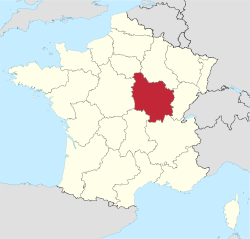
Back Boergondië (gewes) Afrikaans Burgund ALS ቡርጎኝ (የቀድሞ ክፍላገር) Amharic Borgonya AN برغونية Arabic Borgoña AST Bourgogne suyu Aymara Burqon Azerbaijani بورقونی AZB Бургундыя Byelorussian
The article's lead section may need to be rewritten. The reason given is: it does not summarise the article. (February 2017) |
Burgundy
Bourgogne | |
|---|---|
 | |
| Coordinates: 47°00′N 4°30′E / 47.000°N 4.500°E | |
| Country | |
| Dissolved | 1 January 2016 |
| Prefecture | Dijon |
| Departments | 4
|
| Government | |
| • President | François Patriat (PS) |
| Area | |
• Total | 31,582 km2 (12,194 sq mi) |
| Population (2008-01-01) | |
• Total | 1,631,000 |
| • Density | 52/km2 (130/sq mi) |
| GDP | |
| • Total | €49.189 billion |
| • Per capita | €30,300 |
| Time zone | UTC+01:00 (CET) |
| • Summer (DST) | UTC+02:00 (CEST) |
| ISO 3166 code | FR-D |
| NUTS Region | FR2 |
| Website | www.xn--rgion-bourgogne-bnb.fr (archive) |
Burgundy (/ˈbɜːrɡəndi/ BUR-gən-dee; French: Bourgogne [buʁɡɔɲ] ; Burgundian: Bregogne) is a historical territory and former administrative region and province of east-central France. The province was once home to the Dukes of Burgundy from the early 11th until the late 15th century. The capital, Dijon, was wealthy and powerful, being a major European centre of art and science, and of Western Monasticism.[2] In early Modern Europe, Burgundy was a focal point of courtly culture that set the fashion for European royal houses and their court.[3] The Duchy of Burgundy was a key in the transformation of the Middle Ages towards early modern Europe.
Upon the 9th-century partitions of the Kingdom of Burgundy, the lands and remnants partitioned to the Kingdom of France were reduced to a ducal rank by King Robert II of France in 1004. The House of Burgundy, a cadet branch of the House of Capet, ruled over a territory that roughly conformed to the borders and territories of the modern administrative region of Burgundy. Upon the extinction of the Burgundian male line the duchy reverted to the King of France and the House of Valois.
Following the marriage of Philip of Valois and Margaret III of Flanders, the Duchy of Burgundy was absorbed into the Burgundian State alongside parts of the Low Countries which would become collectively known as the Burgundian Netherlands. Upon further acquisitions of the County of Burgundy, Holland, and Luxembourg, the House of Valois-Burgundy came into possession of numerous French and imperial fiefs stretching from the western Alps to the North Sea, in some ways reminiscent of the Middle Frankish realm of Lotharingia.
The Burgundian State,[4] in its own right, was one of the largest ducal territories that existed at the time of the emergence of early Modern Europe. It was regarded as one of the major western European powers of the 14th and 15th centuries. The Dukes of Burgundy were among the wealthiest and the most powerful princes in Europe and were sometimes called "Grand Dukes of the West".[5] Through its possessions the Burgundian State was a major European centre of trade and commerce.
The extinction of the dynasty led to the absorption of the duchy itself into the French crown lands by King Louis XI, while the bulk of the Burgundian possessions in the Low Countries passed to Duke Charles the Bold's daughter, Mary, and her Habsburg descendants. Thus the partition of the Burgundian heritage marked the beginning of the centuries-long French–Habsburg rivalry and played a pivotal role in European politics long after Burgundy had lost its role as an independent political identity.
- ^ "EU regions by GDP, Eurostat". Retrieved 18 September 2023.
- ^ Bouchard, Constance B. (July 1990). "Merovingian, Carolingian and Cluniac Monasticism: Reform and Renewal in Burgundy". The Journal of Ecclesiastical History. 41 (3): 365–388. doi:10.1017/S0022046900075199. ISSN 1469-7637. S2CID 162228105.
- ^ Wim, Blockmans (2013). Staging the Court of Burgundy : proceedings of the Conference "The splendour of Burgundy". Harvey Miller. ISBN 978-1-905375-82-0. OCLC 913446839.
- ^ Schnerb, Betrand (1999). L'État bourguignon (in French). Paris: Perrin. ISBN 978-2-262-02360-7.
- ^ Doudet, Estelle (15 December 2002). "Le surnom du prince: la construction de la mémoire historique par un Rhétoriqueur". Questes (2): 6–7. doi:10.4000/questes.2597. ISSN 2102-7188.

